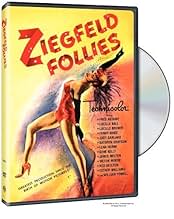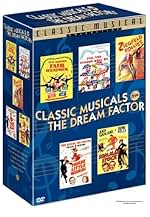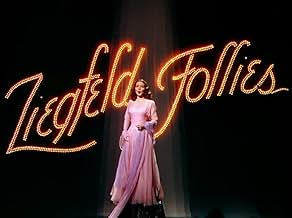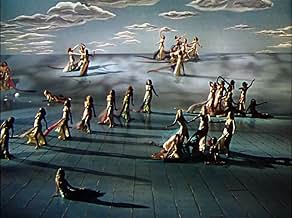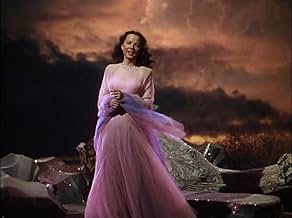IMDb RATING
6.4/10
3.7K
YOUR RATING
The late, great impresario Florenz Ziegfeld Jr. looks down from Heaven and ordains a new revue in his grand old style.The late, great impresario Florenz Ziegfeld Jr. looks down from Heaven and ordains a new revue in his grand old style.The late, great impresario Florenz Ziegfeld Jr. looks down from Heaven and ordains a new revue in his grand old style.
- Awards
- 1 win & 1 nomination
Storyline
Did you know
- TriviaThe machine producing the bubbles for the finale was responsible for one of the greatest filming fiascoes in movie history. On the first day of filming the finale, the gas produced by the bubbles caused Vincente Minnelli's cameraman to faint on top of a forty foot lift. While Minnelli struggled to stop his cameraman from falling, the bubbles continued to pour from the machine to such an extent that the soundstage was flooded with bubbles, and no one could get close enough to turn the machine off. Eventually, the fire brigade was called to turn stop it. Afterwards, teams of workers used large rackets to keep them under control, but the gas from the bubbles remained a constant hazard, and between each take Minnelli would order the soundstage's doors open so the cast and crew could breathe. James Melton filmed with a wet handkerchief in his mouth to protect his voice. Fred Astaire and Lucille Bremer's dance was removed completely, since in every take of them, the bubbles obscured part of their face.
- GoofsTowards the end of the "This Heart of Mine" number, as Fred Astaire and Lucille Bremer begin to dance back to the palace, dancers in the background (screen left) clearly are struggling to stabilize some of the antler-tree props.
- Quotes
Florenz Ziegfeld Jr.: Children play with the dreams of tomorrow. And old men play with the memories of yesterday.
- Crazy creditsZiegfeld Follies credits are in alphabetical order. That is why "Bunin" comes before "Charisse"
- Alternate versionsThere is an Italian edition of this film on DVD, "FOLLIE DI ZIEGFELD", re-edited in double version (1.33:1 and 1.78:1) with the contribution of film historian Riccardo Cusin This version is also available for streaming on some platforms.
- ConnectionsEdited into Hollywood: The Dream Factory (1972)
- SoundtracksHere's to the Girls
Music by Roger Edens
Lyrics by Arthur Freed
Sung by Fred Astaire, chorus
Danced by Cyd Charisse, Lucille Ball, chorus
Featured review
Let's give this movie credit for one thing: it doesn't claim to be anything other than what it is: an unconnected series of musical numbers and comedy sketches, meant to honor the late Florenz Ziegfeld. So, if that is what you want, terrific. If a particular scene bores you, you can fast-forward through it without missing anything.
The strength of the film was the wise decision to let Fred Astaire appear in more than one number. His dancing and on-screen personality are always delightful, because his joy in performing is obvious and catching. The highlight of the movie comes in the last performance, when he performs a wonderful tap-dance and singing number with Gene Kelly. They are so palpably having a good time that you almost forget how dreary so much of the rest of the film was!
The comedy sketches are absolutely the most miserable and un-funny things ever captured on celluloid. Painful, painful, painful. Good grief, do they drag on forever. Keenan Wynn performs an old Vaudeville sketch in which a man cannot get the operator to put his call through to a nearby number, while a parade of other characters have no problem putting calls through to the most obscure and distant locations on the planet. Potentially funny, yes? Well, yes, when Lou Costello did it two years earlier in "Who Done It" - that was the definitive version of the sketch. It is one of the funniest things Lou ever did. Why in the world would MGM have Wynn try to do the same sketch - he tries very hard to mimic Lou Costello's facial contortions and grunts and squeals of frustration - but it stinks.
And the "Pay him the two dollars" routine with Victor Booth and Edward Arnold - well, if this represents Vaudeville at its best, then I guess I don't regret not having been alive to see it after all. And Victor Hume takes a rare stab at comedy too; he appears to be trying to mimic Shemp Howard, and none too well at that.
The musical numbers in general are what you would expect from MGM - lavish, expensive-looking, and otherwise spectacular.
While it may not be everyone's cup of tea, I actually enjoyed the claymation at the beginning of the movie. One of the most bizarre and surreal scenes in any MGM movie ever has to be the 45 seconds of Eddie Cantor, in glorious claymation, and in blackface, for goodness sake, singing "If you knew Susie". It is hilarious, and the claymation really captures Cantor's performance style to a Tee - for comparison, I strongly suggest you watch "A Few Minutes with Eddie Cantor" (1923, in sound) on Youtube.
And speaking of classic Hollywood racial insensitivity, a long "drama in pantomime" features Fred Astaire and as a Chinese, stalking another white actress pretending to be Chinese. You really have to shake your head. And are Fred and Gene dancing in front of a statue of Civil War General Nathan Bedford Forrest? Perhaps not, but he sure looks Confederate....
Like I said, Ziegfeld Follies gives you get exactly what it claims to give you. But have the fast-forward ready.
The strength of the film was the wise decision to let Fred Astaire appear in more than one number. His dancing and on-screen personality are always delightful, because his joy in performing is obvious and catching. The highlight of the movie comes in the last performance, when he performs a wonderful tap-dance and singing number with Gene Kelly. They are so palpably having a good time that you almost forget how dreary so much of the rest of the film was!
The comedy sketches are absolutely the most miserable and un-funny things ever captured on celluloid. Painful, painful, painful. Good grief, do they drag on forever. Keenan Wynn performs an old Vaudeville sketch in which a man cannot get the operator to put his call through to a nearby number, while a parade of other characters have no problem putting calls through to the most obscure and distant locations on the planet. Potentially funny, yes? Well, yes, when Lou Costello did it two years earlier in "Who Done It" - that was the definitive version of the sketch. It is one of the funniest things Lou ever did. Why in the world would MGM have Wynn try to do the same sketch - he tries very hard to mimic Lou Costello's facial contortions and grunts and squeals of frustration - but it stinks.
And the "Pay him the two dollars" routine with Victor Booth and Edward Arnold - well, if this represents Vaudeville at its best, then I guess I don't regret not having been alive to see it after all. And Victor Hume takes a rare stab at comedy too; he appears to be trying to mimic Shemp Howard, and none too well at that.
The musical numbers in general are what you would expect from MGM - lavish, expensive-looking, and otherwise spectacular.
While it may not be everyone's cup of tea, I actually enjoyed the claymation at the beginning of the movie. One of the most bizarre and surreal scenes in any MGM movie ever has to be the 45 seconds of Eddie Cantor, in glorious claymation, and in blackface, for goodness sake, singing "If you knew Susie". It is hilarious, and the claymation really captures Cantor's performance style to a Tee - for comparison, I strongly suggest you watch "A Few Minutes with Eddie Cantor" (1923, in sound) on Youtube.
And speaking of classic Hollywood racial insensitivity, a long "drama in pantomime" features Fred Astaire and as a Chinese, stalking another white actress pretending to be Chinese. You really have to shake your head. And are Fred and Gene dancing in front of a statue of Civil War General Nathan Bedford Forrest? Perhaps not, but he sure looks Confederate....
Like I said, Ziegfeld Follies gives you get exactly what it claims to give you. But have the fast-forward ready.
- audiemurph
- Feb 19, 2012
- Permalink
- How long is Ziegfeld Follies?Powered by Alexa
Details
- Release date
- Country of origin
- Language
- Also known as
- Ziegfeld Follies of 1944
- Filming locations
- Production company
- See more company credits at IMDbPro
Box office
- Budget
- $3,240,816 (estimated)
- Runtime1 hour 50 minutes
- Color
- Aspect ratio
- 1.37 : 1
Contribute to this page
Suggest an edit or add missing content



